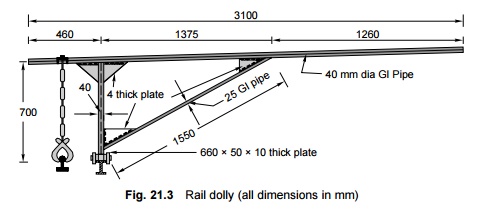Chapter: Civil : Railway Airport Harbour Engineering : Railway Engineering : Rehabilitation and Renewal of Track
Execution of Track Renewal or Track Re-laying Work
Execution of Track Renewal or Track
Re-laying Work
Track renewal or track re-laying
work can be done either manually or by mechanical means. These works involve
the following steps.
(a) Survey of
the section
(b) Preliminary
works
(c) Actual
execution of track renewal works
1 Survey of the Section
The section to be re-laid should
be surveyed in advance. The survey includes the preparation of the longitudinal
sections of the track, including the existing rail levels, at every 100 m and
at obligatory points such as level crossings, road over bridges, and overhead
crossings. The cross sections are taken at every 50 m in station yards and on
platform lines, at the site of foot over bridges, overhead watering
arrangements, etc.
2 Preliminary Works
Preliminary works are the minor
works undertaken prior to the actual work involved in track renewal. These
works include the following tasks.
(a) Unloading
track materials
(b) Ballasting
the section
(c) Fixing
level and centre-line pegs
(d) Arranging
traffic blocks
Each one
of these preliminary works is briefly discussed here.
Unloading track materials It should
be ensured that the relevant materials are unloaded at the precise
location where they are to be laid, as explained in the following.
Rails These
should be unloaded in pairs on the cess on either side of the track in the
case of single-line sections and between two tracks in the case of
double-line sections.
Sleepers The sleepers are taken
directly to the site in wagons and unloaded on the section. They
are piled in small stacks and subsequently laid at their final location.
Alternatively, they are laid 'end on' with respect to their future location,
wherever possible.
Fittings Small
fittings are likely to be lost or stolen. These should, therefore, be unloaded
in depots, gang huts, gate lodges, etc., and taken to the site as and when
required. New fish plates are graphited and fish bolts and nuts are oiled and
lubricated before use.
Ballasting the section An
adequate quantity of ballast is provided in advance and is unloaded at
the site, preferably with the help of ballast trains. Some of the ballast can
also be collected, or even procured, at the cess to avoid ballast deficiency.
The ballast should preferably be deep screened in advance.
Fixing centre-line and level pegs
Centre-line
and level pegs are provided at every 50 m.
Arranging traffic blocks The
arrangement of traffic blocks should be finalized in consultation with
the operating department. A joint memorandum of understanding should be
prepared for drawing up the exact programme of traffic blocks.
3 Actual Execution of Track Renewals Work
Once the preliminary works are
completed, the actual work of track renewal can start. This involves the
following tasks.
Setting up traffic block A traffic
block of about 2 to 4 hours is set up in order to execute the
work of track re-laying.
Dismantling old track The old
track is dismantled by removing the fish-bolts and fish plates as
well as the sleeper fastenings. The old rails and sleepers are then removed and
stacked on the side of the track opposite the new material.
Deep screening The
ballast should be deep screened if this was not done earlier along
with the other preliminary works. The ballast should be dressed and properly
levelled in accordance with the correct profile.
Linking new track After the
ballast has been laid in keeping with the correct level, the
sleepers are laid almost in their correct places, and the rails are linked over
them using proper expansion liners.
Packing new track The track
is then lifted to the correct level, aligned, and packed either
manually or with the help of machines.
4 Progress and Output
On an average, the renewal of
about 0.4 km of track can be achieved by 15 to 30 gangs in a 3 to 4 hour
traffic block. The deep screening of the ballast should, however, have been
completed ahead of re-laying work.
5 Rail Dolly
The rail dolly (Fig. 21.3) is an equipment used for the quick
and easy transportation of rails. It consists of a tabular frame fitted with a
chain that ends in a rail clamp. There are two double-flanged wheels with ball
bearings, which run on rails. A leverage handle is available for operating and
moving the rails. The equipment, weighing about 55 kg, is extremely useful for
carrying rails and sleepers to the site of work. In the event of an approaching
train, the rail as well as the equipment can be cleared off the track within 10
seconds.

Related Topics